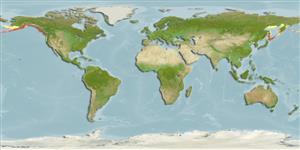Environment: milieu / climate zone / depth range / distribution range
Ökologie
seewasser demersal; tiefenbereich ? - 91 m (Ref. 2850). Temperate
North Pacific: Kamchatka, Russia through the Aleutian chain and the Bering Sea to the Bering Strait coasts of Alaska and Humboldt Bay, California, USA.
Size / Gewicht / Alter
Maturity: Lm ? range ? - ? cm
Max length : 42.0 cm TL Männchen/unbestimmt; (Ref. 2850)
Kurzbeschreibung
Bestimmungsschlüssel | Morphologie | Morphometrie
Rückenflossenstacheln (insgesamt) : 61 - 62; Rückenflossenweichstrahlen (insgesamt) : 0; Afterflossenstacheln: 1; Afterflossenweichstrahlen: 44 - 51. Caudal rounded (Ref. 6885). Pale brown with white to cream markings, paler below; irregular light areas on upper part of body, and vertical light bars below; dark bars run down from eyes; prominent dark bars on the dorsal, caudal and anal fins (Ref. 6885).
Usually among seaweed on rocky bottoms (Ref. 2850); in reef crevices, usually among algae (Ref. 51666). Occurs in subtidal areas to 91 m depth (Ref. 2850).
Life cycle and mating behavior
Maturities | Fortpflanzung | Spawnings | Egg(s) | Fecundities | Larven
Eschmeyer, W.N., E.S. Herald and H. Hammann, 1983. A field guide to Pacific coast fishes of North America. Boston (MA, USA): Houghton Mifflin Company. xii+336 p. (Ref. 2850)
IUCN Rote Liste Status (Ref. 130435)
Bedrohung für Menschen
Harmless
Nutzung durch Menschen
Fischereien: kommerziell; Aquarium: Öffentliche Aquarien
Tools
Zusatzinformationen
Download XML
Internet Quellen
Estimates based on models
Preferred temperature (Ref.
123201): 4.1 - 10.4, mean 8 °C (based on 180 cells).
Phylogenetic diversity index (Ref.
82804): PD
50 = 0.5039 [Uniqueness, from 0.5 = low to 2.0 = high].
Bayesian length-weight: a=0.00372 (0.00147 - 0.00941), b=3.17 (2.95 - 3.39), in cm total length, based on LWR estimates for this (Sub)family-body shape (Ref.
93245).
Trophic level (Ref.
69278): 3.6 ±0.5 se; based on size and trophs of closest relatives
Widerstandsfähigkeit (Ref.
120179): sehr niedrig, Verdopplung der Population dauert mehr als 14 Jahre. (Preliminary K or Fecundity.).
Fishing Vulnerability (Ref.
59153): Low to moderate vulnerability (32 of 100).
